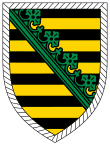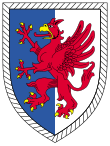13th Panzer Grenadier Division (Bundeswehr)
|
13th Panzer Grenadier Division |
|
|---|---|
 Association badge |
|
| active | October 4, 1990 to June 28, 2013 |
| Country |
|
| Armed forces | armed forces |
| Armed forces |
|
| Subordinate troops |
|
| Strength | last ~ 12,500 men |
| Insinuation |
|
| Seat of the staff | Leipzig |
| motto | United ahead! |
| commander | |
| last commander | Major General Erich Pfeffer |
The 13th Panzer Grenadier Division was a 12,500-strong division of the Army of the Bundeswehr . The division headquarters were located in the General-Olbricht barracks in Leipzig until the end . The division was one of the army's stabilizing forces. It included almost all army units in the new federal states. In terms of service, the division was ultimately under the command of the Army . On October 26, 2011 the dissolution of the division was announced. On June 28, 2013 the appeal was announced. The newly established training command was formed from parts of the agency . The former units of the 13th Panzer Grenadier Division had already been transferred to the 1st Panzer Division and the Airmobile Operations Division (later the 10th Panzer Division ).
assignment
The division planned and led missions in national and multinational formations for national defense and the defense of allies. As a division of the stabilization forces, the association was also able to carry out missions as a lead division with the aim of conflict prevention and peace stabilization within the framework of NATO or the European Union . The division regularly provided staff for the contingents required for this. The division was able to lead combat with combined arms and trained subordinate units for this purpose, practiced them and thus also ensured the ability to grow and survive. The training company no longer focused on practicing classic high-intensity combat against a military organized enemy.
Association badge
The three-part association badge takes up the coats of arms of the original stationing states of Saxony , Thuringia and Bavaria . Essential elements are:
- Above left (heraldic right): In the glaze blue shield the four times the same width red and silver striped, gold armored and crowned colored lions of the Ludowingers . This field stands for the Free State of Thuringia.
- Above right (heraldic left): In the field divided nine times by black and gold, a diagonal green diamond wreath . This symbol stands for the Free State of Saxony.
- Below: The shield is roughened diagonally to the right in white (silver) and blue. This symbol stands for the Free State of Bavaria.
The coat of arms is framed by a silver cord with black thread, as is traditional for a division.
The old association badge, however, only referred to the acceding countries. In the lower raised tip of the shield, instead of the Bavarian diamonds, the colors black and yellow for Saxony were shown, which are now below the diamond wreath, as it is also shown in the state coat of arms. The field under the diamond wreath, on the other hand, was once white and green and thus corresponded to the colors of the flag of Saxony .
structure
The following structure shows the last status before the dissolution in June 2013. The note “ Coleur ” refers to the “partner unit” of the supplementary troop unit.
-
 Headquarters / Headquarters Company 13th Panzer Grenadier Division, Leipzig
Headquarters / Headquarters Company 13th Panzer Grenadier Division, Leipzig
-
 of the Army Music Corps 2 , Kassel
of the Army Music Corps 2 , Kassel
-
 Telecommunications Battalion 610, Prenzlau (subordinate troop service, for training and use to Command Support Brigade of the Multinational Corps Northeast )
Telecommunications Battalion 610, Prenzlau (subordinate troop service, for training and use to Command Support Brigade of the Multinational Corps Northeast )
-
Panzer Grenadier Brigade 37
Note: The Panzergrenadierbrigade 37 is nicknamed "Free State of Saxony"
-
 Headquarters / headquarters company Panzergrenadierbrigade 37 , Frankenberg / Sa.
Headquarters / headquarters company Panzergrenadierbrigade 37 , Frankenberg / Sa.
-
 Telecommunications Battalion 701, Frankenberg (to be disbanded)
Telecommunications Battalion 701, Frankenberg (to be disbanded) -
 Reconnaissance Battalion 13 , Gotha
Reconnaissance Battalion 13 , Gotha
 Reconnaissance Battalion 910, Gotha (Color: Reconnaissance Battalion 13)
Reconnaissance Battalion 910, Gotha (Color: Reconnaissance Battalion 13)-
 Panzer Pioneer Battalion 701, Gera
Panzer Pioneer Battalion 701, Gera
-
 Pionierbataillon 903, Gera (Color: Panzerpionierbataillon 701. Not active. No large equipment of its own available or long-term storage.)
Pionierbataillon 903, Gera (Color: Panzerpionierbataillon 701. Not active. No large equipment of its own available or long-term storage.)
-
 Panzergrenadierbataillon 371 , Marienberg
Panzergrenadierbataillon 371 , Marienberg
-
 Panzergrenadierbataillon 909, Marienberg (color: Panzergrenadierbataillon 371, not active, no large equipment of its own or long-term storage.)
Panzergrenadierbataillon 909, Marienberg (color: Panzergrenadierbataillon 371, not active, no large equipment of its own or long-term storage.)
-
 Pionierkompanie 953, Marienberg (color: Panzergrenadierbataillon 371. Intended for ZMZ coordinated by SKB departments . Partially active. Large equipment is kept at the local ZMZ base.)
Pionierkompanie 953, Marienberg (color: Panzergrenadierbataillon 371. Intended for ZMZ coordinated by SKB departments . Partially active. Large equipment is kept at the local ZMZ base.)
-
 391 Panzer Grenadier Battalion , Bad Salzungen
391 Panzer Grenadier Battalion , Bad Salzungen
-
 Panzerbataillon 393, Bad Salzungen (will be relocated to Bad Frankenhausen)
Panzerbataillon 393, Bad Salzungen (will be relocated to Bad Frankenhausen) -
 Logistikbataillon 131, Bad Frankenhausen (will be converted into supply battalion 131)
Logistikbataillon 131, Bad Frankenhausen (will be converted into supply battalion 131)
-
Panzer Grenadier Brigade 41
Note: The Panzer Grenadier Brigade 41 is nicknamed "Vorpommern"
-
 Headquarters / headquarters company Panzergrenadierbrigade 41 , Neubrandenburg
Headquarters / headquarters company Panzergrenadierbrigade 41 , Neubrandenburg
-
 Fernmeldebataillon 801, Neubrandenburg (to be dissolved)
Fernmeldebataillon 801, Neubrandenburg (to be dissolved) -
 Reconnaissance Battalion 6 "Holstein", Eutin
Reconnaissance Battalion 6 "Holstein", Eutin
-
 Panzer Pioneer Battalion 803, Havelberg
Panzer Pioneer Battalion 803, Havelberg
-
 Pionierbataillon 901, Havelberg (Couleur: Panzerpionierbataillon 803. Not active. No own large equipment available or long-term storage.)
Pionierbataillon 901, Havelberg (Couleur: Panzerpionierbataillon 803. Not active. No own large equipment available or long-term storage.)
-
 Pionierkompanie 952, Havelberg (color: Panzerpionierbataillon 803. Intended for ZMZ coordinated by SKB departments . Partially active. Large equipment is kept at the local ZMZ base.)
Pionierkompanie 952, Havelberg (color: Panzerpionierbataillon 803. Intended for ZMZ coordinated by SKB departments . Partially active. Large equipment is kept at the local ZMZ base.)
-
 Panzergrenadierbataillon 401, Hagenow
Panzergrenadierbataillon 401, Hagenow
-
 Panzerbataillon 413, Torgelow (will be converted into Jägerbataillon 413)
Panzerbataillon 413, Torgelow (will be converted into Jägerbataillon 413) -
 Panzergrenadierbataillon 411, square
Panzergrenadierbataillon 411, square
-
 Pionierkompanie 951, Viereck (color: Panzergrenadierbataillon 411. Intended for ZMZ coordinated by SKB departments . Partially active. Large equipment is available at the local ZMZ base.)
Pionierkompanie 951, Viereck (color: Panzergrenadierbataillon 411. Intended for ZMZ coordinated by SKB departments . Partially active. Large equipment is available at the local ZMZ base.)
-
 Panzergrenadierbataillon 908, Viereck (Couleur: Panzergrenadierbataillon 411. Not active. No large equipment available or long-term storage.)
Panzergrenadierbataillon 908, Viereck (Couleur: Panzergrenadierbataillon 411. Not active. No large equipment available or long-term storage.)
-
 Logistics battalion 142, Basepohl (will be converted into supply battalion 142 and relocated to Hagenow)
Logistics battalion 142, Basepohl (will be converted into supply battalion 142 and relocated to Hagenow)
-
history
The history of the division began with the dissolution of the National People's Army of the GDR in 1990, when the units of Military District III were combined in the newly created Military District Command VII - which has been known as Division / Wehrbereichskommando (WBK) VII since 1991. This association was established in 1995 in WBK VII / 13. Panzergrenadierdivision renamed and the subordinate brigades, initially referred to as Heimatschutzbrigades, were renamed Panzergrenadierbrigade 37 , Panzergrenadierbrigade 38 and Panzerbrigade 39 . In 1996, Panzer Brigade 39 moved to Wehrbereichskommando IV / 5th Panzer Division . In 1997, Panzer Brigade 42 moved from the 14th Panzer Grenadier Division to the division. In 1996 the division provided troops for the IFOR mission in Bosnia and Herzegovina . In 1997 the division supported the Oder flood . In 1998 the division provided forces for the 2nd SFOR , followed by further operations in the Balkans in 2001/2002 (including SFOR, KFOR ). Since 2001 the division has been called the 13th Panzer Grenadier Division after the separation from the WBK. In 2002 the division gave up Artillery Regiment 13 and Panzer Brigade 42 was disbanded, as was the Command Support Regiment 70 and Panzer Grenadier Brigade 38 in 2003. During the Elbe flood in 2002, the division provided support with its own resources. In 2006 the brigade provided forces for the 11th German ISAF contingent . In 2007, Panzergrenadierbrigade 41 moved from the 14th Panzergrenadier Division to the 13th Panzergrenadier Division, and from the brigade, which had meanwhile been reclassified to Jägerbrigade 37 , the armored infantry brigade was reorganized as the 37th Panzer Reconnaissance Battalion as part of this reconnaissance battalion 13 subordinated to the Panzer Grenadier Brigade 37 and the units of Panzer Reconnaissance Company 370 and 390 previously subordinated to the Panzer Reconnaissance Battalion 13 were dissolved or incorporated into it.
On October 26, 2011 the dissolution of the division was announced. The newly established training command was formed from the agency . The Panzergrenadierbrigade 37 was subordinated to the new 10th Panzer Division in Veitshochheim, the Panzergrenadierbrigade 41 to the 1st Panzer Division in Oldenburg.
Partnerships
The division maintained partnership relationships with the 1st (US) Infantry Division and the 11th Polish Armored Cavalry Division from Żagań .
Commanders
| No. | Surname | Beginning of the appointment | End of appointment |
|---|---|---|---|
| 8th | Major General Erich Pfeffer | August 1, 2011 | June 28, 2013 |
| 7th | Major General Achim Lidsba ( Brigadier General Klaus von Heimendahl led from July 14 to 31, 2011 ) |
June 21, 2010 | July 14, 2011 |
| 6th | Major General Reinhard Kammerer | August 2006 | June 21, 2010 |
| 5 | Major General Roland Kather | September 19, 2003 | August 2006 |
| 4th | Major General Wolf-Dieter Löser | April 1, 2001 | September 19, 2003 |
| 3 | Major General Werner Widder | April 1, 1998 | March 31, 2001 |
| 2 | Major General Michael von Scotti | April 1, 1995 | March 31, 1998 |
| 1 | Major General Ekkehard Richter | October 1990 | March 31, 1995 |
Individual evidence
- ^ The stationing of the Bundeswehr - October 2011. (PDF; 2.8 MB) BMVg, October 26, 2011, archived from the original on November 11, 2011 ; Retrieved October 26, 2011 .
- ↑ BMVg press release, August 1, 2011
Coordinates: 51 ° 22 ′ 49 ″ N , 12 ° 21 ′ 4 ″ E



